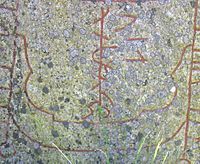Bind rune: Difference between revisions
Appearance
Content deleted Content added
Added newly uploaded image. |
slight tidy of grammar |
||
| Line 3: | Line 3: | ||
<!-- Image with inadequate rationale removed: [[Image:Bluetooth.svg|thumb|90px|Bluetooth logo]] --> |
<!-- Image with inadequate rationale removed: [[Image:Bluetooth.svg|thumb|90px|Bluetooth logo]] --> |
||
A '''bind rune''' is a [[Ligature (palaeography)|ligature]] of two or more [[Runic alphabet|runes]]. They are extremely rare in [[Viking Age]] inscription, but |
A '''bind rune''' is a [[Ligature (palaeography)|ligature]] of two or more [[Runic alphabet|runes]]. They are extremely rare in [[Viking Age]] inscription, but are common in pre-Viking Age ([[Proto-Norse]]) and in post-Viking Age (medieval) inscriptions.<ref name=ENOKSEN>Enoksen, Lars Magnar (1998). ''Runor: historia, tydning, tolkning'', p. 84. Historiska Media, Falun. ISBN 91-88930-32-7</ref> |
||
==Examples== |
==Examples== |
||
Revision as of 19:27, 20 July 2008


A bind rune is a ligature of two or more runes. They are extremely rare in Viking Age inscription, but are common in pre-Viking Age (Proto-Norse) and in post-Viking Age (medieval) inscriptions.[1]
Examples
Elder futhark
Examples found in Elder Futhark inscriptions include:
- Stacked Tiwaz runes: Kylver Stone, Seeland-II-C
- Gebô runes combined with vowels: Kragehul I
Anglo-Saxon Futhorc
Examples from Anglo-Saxon Futhorc:
Modern use
- The Bluetooth logo merges the runes analogous to the modern Latin alphabet letters h and b;
 (Hagall) and
(Hagall) and  (Berkanan) together, forming a bind rune.
(Berkanan) together, forming a bind rune.
Gallery
-
The i ͡ŋ bindrune.
-
The a and the þ rune in ligature on the Rök Runestone.
-
The "chair s" bindrune of the Younger Futhark.
-
The s and k runes in ligature in the Old Norse word skipari ("sailor") on the Tuna Runestone in Småland.
-
A bind rune found on a runestone from Sønder Kirkby, Denmark.
See also
References
- ^ Enoksen, Lars Magnar (1998). Runor: historia, tydning, tolkning, p. 84. Historiska Media, Falun. ISBN 91-88930-32-7




